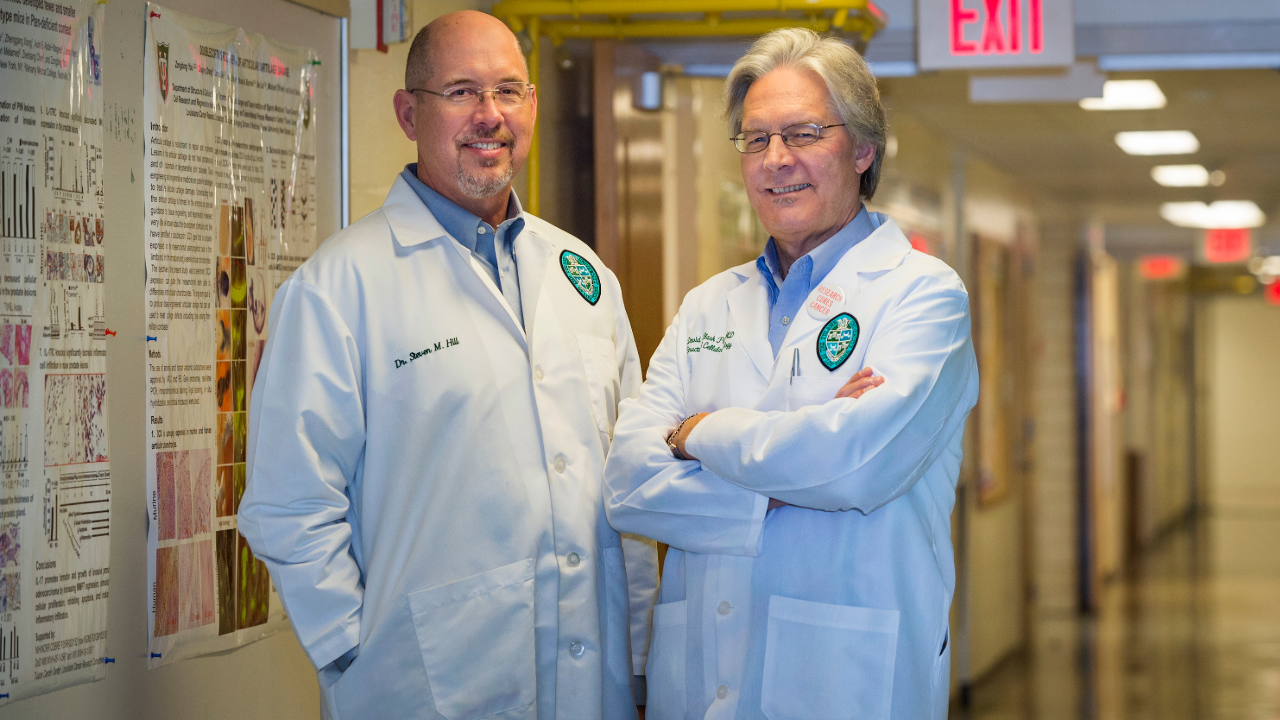Tulane circadian biology researchers featured in documentary on melatonin & health
Tulane cancer researchers David Blask, PhD, MD, and Steven Hill, PhD, were recently featured in a South Korean documentary on the health impacts of the pineal gland hormone melatonin.
The Fact, produced by broadcasting company TV Chosun, is the fourth documentary their groundbreaking work has been featured in since their near four-decade-long collaboration started back in 1983, when Dr. Hill was a grad student working in Dr. Blask's lab at the University of Arizona. "When you're just starting out, you really don't know where the research is going to lead you," said Blask. "Now, looking back at the arc of our work, we have a better appreciation for the impact of those early experiments."
The producers of the documentary chose to feature Blask and Hill because their research has helped to answer several critical questions involving the cancer-inhibitory effects of melatonin — a hormone produced by the pineal gland during total darkness, typically at night during sleep — and whether the interruption of melatonin production due to exposure to light at night could impact its ability to prevent or slow tumor formation, growth and metastasis.
Does Melatonin Inhibit the Ability of Breast Cancer Cells to Grow?
Back in the early 1980s, Blask was working on an animal model for breast cancer and his data revealed that melatonin may be inhibiting the growth of breast tumors. But how? Was it a direct or indirect effect?
"When Steve joined my lab, he established a human breast cancer cell culture system," said Blask. "This would be his dissertation project. It was a very simple question — Does melatonin directly inhibit the ability of these breast cancer cells to grow?"
Dr. Hill tested a range of melatonin concentrations, from very low through the physiological range that the pineal gland secretes into the blood stream at night up through very high concentrations. "At very low concentrations, melatonin had no effect, but then as we started to get into larger concentrations, we saw an increase in the inhibition of the growth of these cells that peaked with exposure to normal nighttime melatonin concentrations and then tapered off again as concentrations increased beyond that point," said Blask. "What surprised us was that the nighttime physiological range of melatonin concentrations was the sweet spot, so to speak."
The data revealed that melatonin had a definite, direct inhibitory effect on the growth of human breast cancer cells and that it was most effective at the normal physiologic concentrations produced by the pineal gland at night in humans.
"That was Steve's first paper, published in Cancer Research," said Blask. "It was highly cited then and still is today. It got the whole ball rolling, and all the research we did from that day until now has riffed off of that idea."
Does Exposure to Light at Night Diminish Melatonin's Anti-Cancer Activity?
Fast forward to 2005. Dr. Blask is running a lab in Cooperstown, New York, where he and his group, including research colleague Robert Dauchy (photo inset above), published another landmark paper in Cancer Research where they showed that nighttime concentrations of melatonin in human blood perfused through human breast cancers grown in a rat model could inhibit the growth of the tumor cells. "This was a unique human-to-human hybrid, tissue-isolated system developed by Bob Dauchy in which the rat was just an anchor point for the tumor to grow," Blask said.
When the team took it a step further and perfused the tumors with the blood of human subjects exposed to the melatonin-suppressive effects of light at night in the lab of collaborator Dr. George Brainard at Thomas Jefferson University, the tumors were not inhibited. "In fact, they grew at a very high rate," said Blask. "That paper proved what we originally speculated in Steve's first paper in 1988 — that the nighttime concentration of melatonin circulating in human blood is in fact a protective, circadian anti-breast cancer signal — and we know now from our subsequent work here at Tulane with Dr. Hill that it isn't just inhibitory to breast cancer but prostate cancer and other cancers as well."
Does Exposure to Light at Night Block Melatonin's Suppression of Tumor Metabolism?
Dr. Blask and Bob Dauchy moved from Cooperstown to join Dr. Hill at Tulane in 2008 and opened the Laboratory of Chrono-Neuroendocrine Oncology here.
"Back in Cooperstown, Bob and I had shown in initial experiments that the nighttime melatonin signal had a big impact on suppressing a type of metabolism important to the growth of tumors called the Warburg effect." Tumors need to metabolize glucose and fat to grow. Dauchy and Blask discovered that melatonin could block the uptake and utilization of glucose and fat, essentially blocking the Warburg effect and tumor proliferation.
In 2014, the team published a critical follow-up paper in PLOS One that not only confirmed the ability of melatonin to diminish the Warburg effect but most importantly revealed the opposite — what they called the "hyper-Warburg effect" — when the test animals were subjected to dim light at night, causing circadian disruption by preventing the production of melatonin. "In those animals, the Warburg effect was active 24 hours a day," said Blask. "Their tumors were growing at an accelerated rate, anywhere from two to five times faster than normal, resulting from hyper-Warburg and hyper-fat metabolism."
Does Exposure to Light at Night Impact the Effectiveness of Tamoxifen?
The team, this time led by Dr. Hill, published another pivotal paper in 2014 that looked at melatonin and tamoxifen resistance, again in Dauchy's tissue-isolated tumor system. Tamoxifen, a first-line treatment for hormone responsive breast cancer, blocks the action of estrogen. They tested whether the nighttime, circadian melatonin signal would have an impact on the effectiveness of tamoxifen.
"After implantation, Bob Dauchy let the tumors grow to a certain size and then started the animals on treatment with tamoxifen, and those tumors regressed, as you would expect," said Blask. "We wanted to address Dr. Hill's question that if we get rid of the melatonin signal by exposing those animals to dim light at night, would we lose or diminish the effects of the tamoxifen. To our surprise, when we gave tamoxifen to those animals exposed to light at night, they responded like there was no tamoxifen at all. The tumors grew just as fast as those in the control animals exposed to dim light at night only."
Does the Quality of Light Matter?
The team's latest research is revealing that it's not just darkness at night that's pivotal, but the quality of the light you're exposed to during the day that is important to melatonin production and overall health.
In 2022, Blask and Dauchy became co-investigators with collaborators at Thomas Jefferson University on a three-year, $1.6 million Department of Energy grant to test how different types of daytime lighting could impact melatonin production.
Published data generated by experiments performed here at Tulane helped to lay the groundwork for this grant. "Our animal studies revealed that blue-enriched LED light exposure rather than fluorescent light during the day, with complete darkness at night, makes the nighttime melatonin peak up to seven-fold higher than it would be normally," said Blask. "It's like these animals were taking a melatonin supplement."
“Indeed, the published data strongly suggested that the research animals subjected to the blue-enriched LED light at daytime, compared with standard fluorescent light, had a marked positive effect on circadian parameters associated with health and wellbeing that may influence scientific outcomes,” said Dauchy.
In subsequent studies using an animal liver cancer model, exposure to blue-enriched LED light during the day rather than white fluorescent light caused the expected spike in melatonin production and therefore increased tumor inhibition in the test animals. Using that same model, his team then hypothesized that if you treated these animals with an anti-liver cancer drug under blue light conditions during the day the tumors would be more responsive to the chemotherapy. "And that's exactly what happened," said Blask. "The liver cancers regressed at twice the rate under the blue light conditions compared to the normal nighttime melatonin surge."
Exposure to Light at Night Labeled as a Possible Carcinogen
There aren't very many basic research laboratories that have been featured in four documentaries, and in reviewing the "arc of their research" from 1983 until today, it's understandable why this team's data has been highlighted time and again.
One other accomplishment of particular note...Their research helped to lay the groundwork for a scientific working group (of which Blask was a member) appointed by the World Health Organization to add shift work and exposure to light at night to its list of probable human carcinogens in 2007.
View the Documentary
The Fact was produced in Korean with no subtitles and can be viewed here. Tulane's interviews, which are in English, begin at 19:14.


